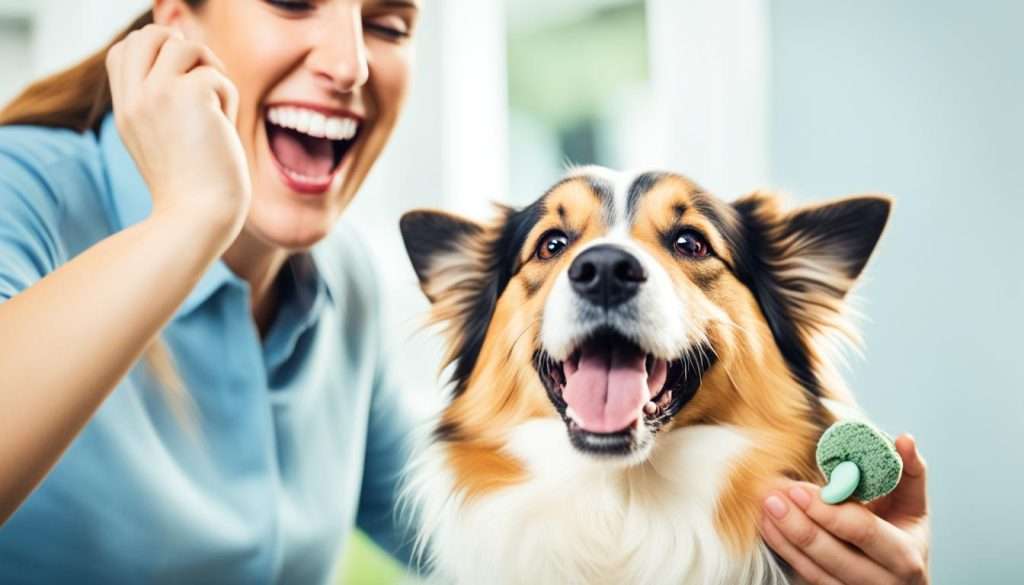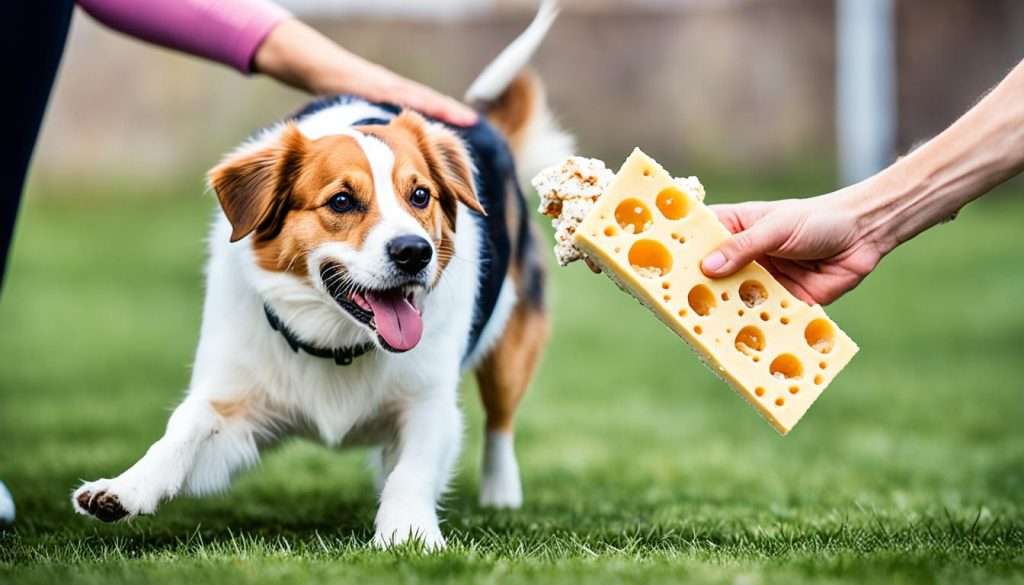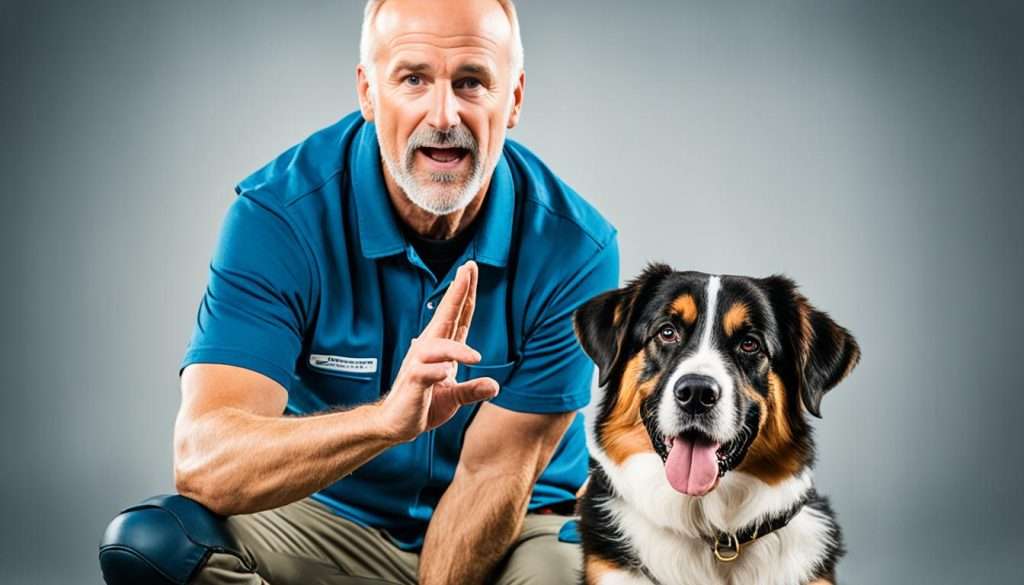Training your dog is essential for both you and your pet’s well-being. Positive reinforcement techniques, such as rewarding good behavior, are highly effective in dog obedience training. Finding the right reward, being consistent in your training, and keeping sessions short but frequent are key elements. It’s also important to start with small tasks and make training fun for both you and your dog. If you need assistance, consider consulting a professional dog trainer or attending a training class.
Key Takeaways:
- Dog obedience training is crucial for a well-behaved and happy pet.
- Positive reinforcement, such as rewarding good behavior, is highly effective in dog training.
- Consistency in training is key to helping your dog understand what is expected of them.
- Training sessions should be kept short and frequent to maintain your dog’s focus.
- Make training fun by incorporating play and variety into the sessions.
The Importance of Positive Reinforcement in Dog Training
In the world of dog training, positive reinforcement is hailed as the most effective technique for shaping your furry friend’s behavior. Instead of resorting to punishment and coercion, positive reinforcement focuses on rewarding desirable behaviors, creating a strong bond between you and your dog.
Positive reinforcement works by associating good behavior with positive outcomes, such as treats, toys, or affection. When your dog performs a desired action, they receive a reward, reinforcing the behavior and encouraging them to repeat it.
Using this reward-based training approach creates a positive and enjoyable learning experience for your dog. They become motivated to learn new behaviors and are more likely to retain what they’ve learned. Additionally, positive reinforcement training leads to faster and more lasting results compared to aversive methods.

Through positive reinforcement, you establish clear communication with your dog, teaching them what you expect in a gentle and motivating way. This method promotes a trusting and cooperative relationship, allowing your dog to flourish and thrive.
| Benefits of Positive Reinforcement in Dog Training |
|---|
| 1. Encourages desirable behaviors |
| 2. Strengthens the bond between you and your dog |
| 3. Builds confidence and trust in your dog |
| 4. Creates a positive and enjoyable training experience |
| 5. Promotes better retention of learned behaviors |
| 6. Reduces stress and anxiety in dogs |
Positive reinforcement can be applied to a wide range of dog training scenarios, from basic commands to complex behaviors. By focusing on rewarding good behavior, you’ll see remarkable progress in your dog’s obedience and overall well-being.
Finding the Right Reward for Your Dog
Every dog is unique, so it’s important to find the right reward that motivates your pet during training. Some dogs are highly food-motivated and will respond well to edible treats. Others are more interested in play and may prefer soft, chewy toys as rewards. For some dogs, affection and praise are the most rewarding. Experiment with different rewards to find what works best for your dog and keeps them engaged and eager to learn.
Food motivation can be a powerful tool in dog training. Use small, tasty treats that your dog finds irresistible. As they perform the desired behavior, reward them immediately with a treat, reinforcing the connection between the behavior and the reward. This food motivation can help your dog associate their training with positive experiences.
Toys can also be great rewards for dogs, especially those who enjoy playing. Choose toys that are interactive and engaging, such as puzzle toys or tug toys. These toys can provide mental stimulation and physical exercise, making them highly rewarding for your dog. Incorporating toys as rewards during training sessions can keep your dog excited and focused.
Affection and praise are powerful rewards, particularly for dogs who thrive on social interaction. Verbal praise, a scratch behind the ears, or a belly rub can convey your happiness and approval, reinforcing your dog’s good behavior. Remember to use a happy and enthusiastic tone to let your dog know they’ve done something right.
Quote:
“Finding the right reward for your dog is like finding the key to their motivation. Whether it’s treats, toys, or affection – discovering what truly drives your furry friend can unlock the door to effective and enjoyable training.”
By using a combination of different rewards based on your dog’s preferences, you can keep them engaged and motivated throughout their training journey. It’s essential to observe your dog’s reactions and adjust your rewards accordingly. Remember, each dog is unique, so what works for one may not work for another. Be patient and persistent in finding the right rewards, and you’ll soon see positive results in your dog’s behavior and training progress.

List of Different Types of Rewards:
| Reward | Description |
|---|---|
| Food | Use tasty treats that your dog loves and finds motivating. |
| Toys | Choose interactive toys that provide mental stimulation and playtime. |
| Affection | Show your love and approval through petting, belly rubs, and verbal praise. |
The Importance of Consistency in Dog Training
Consistency plays a vital role in effective dog training. By using consistent commands and intonation, you can help your dog understand what is expected of them and reinforce good behavior. It is crucial for everyone in the household to be on the same page when it comes to commands and training techniques to avoid confusion.
Dogs thrive on routine and consistency. Establishing a consistent training routine will help them learn and retain the commands and behaviors you are teaching them. When your dog understands that the same rules apply consistently, they will feel more secure and confident in their training.
When training your dog, remember to:
- Use the same commands and intonation every time
- Ensure everyone in the household is using consistent commands
- Create a training routine that your dog can rely on
Consistency also extends beyond training sessions. Incorporating consistent commands and rules into your everyday interactions with your dog will reinforce their training and help them understand what is expected of them in various situations.

| Benefits of Consistency in Dog Training | Tips for Consistent Training |
|---|---|
|
|
Short and Frequent Training Sessions
Dogs have short attention spans, so it’s best to keep training sessions short and frequent. The American Kennel Club recommends keeping sessions to a maximum of five minutes to prevent distractions and frustration. Short, focused sessions allow your dog to stay engaged and retain what they have learned.
Why short sessions are effective
Training your dog in short bursts has several advantages. Firstly, it helps prevent your dog from becoming distracted or bored. By keeping the sessions brief, you can ensure that your dog stays focused and attentive throughout the training. Secondly, short sessions allow your dog to retain information better. When the training sessions are too long, dogs can become overwhelmed, and their ability to remember what they have learned decreases. By keeping the sessions short, you can maximize your dog’s learning capacity.
“Short, focused training sessions allow your dog to stay engaged and retain what they have learned.”
Additionally, frequent training sessions provide consistency and reinforcement. Dogs learn through repetition, so having regular training sessions will reinforce the behaviors and commands you are teaching them. It’s recommended to train your dog at least once or twice a day, depending on their age and energy level. By incorporating training into your dog’s daily routine, you are effectively reinforcing their learning and promoting long-term behavior change.
Training in different locations
To ensure that your dog can generalize their training, it’s important to practice commands in different locations and environments. Training your dog in various settings helps them understand that commands are applicable regardless of the surroundings. Start by practicing in a quiet, familiar space and gradually progress to busier environments with more distractions. This process teaches your dog to focus on your commands and follow them, regardless of the surroundings.
Building Behavior in Stages
When it comes to teaching more complex behaviors or modifying unwanted behaviors, breaking them down into smaller parts can be highly effective. By starting with simple steps and rewarding your dog for any progress, you can gradually build up the behavior over time.
For instance, let’s take the example of training the “come” command. Instead of expecting your dog to immediately understand and come to you from a long distance, start by rewarding them for taking even one step towards you initially. This helps them associate the behavior with positive reinforcement.
As your dog improves, gradually add more steps, increasing the distance they have to come to you. By doing so, you are systematically reinforcing the behavior and helping your dog understand the full command.
Breaking behaviors into stages makes the training process more manageable and increases your dog’s chances of success. It allows your dog to grasp each step before moving on to the next, ensuring a solid foundation for the behavior you are trying to teach.
Example of Building Behavior in Stages:
| Training Command | Stages |
|---|---|
| Stay |
|
| Fetch |
|
| Sit |
|
By following this approach, you can set your dog up for success and ensure steady progress in their training journey. Remember to be patient, provide consistent reinforcement, and celebrate each small achievement along the way.
Incorporating Fun into Training
Training should be enjoyable for both you and your dog. Incorporating fun elements into your training sessions not only keeps your dog engaged but also creates a positive training experience for both of you. By making training fun, you can enhance your dog’s learning and motivation, leading to better training outcomes.
Add Variety with Tricks Training
One way to inject fun into your training sessions is by incorporating tricks training alongside regular obedience training. Teaching your dog fun tricks such as “roll over,” “play dead,” or “fetch a specific object” adds variety and excitement to the training process. Tricks training also helps stimulate your dog mentally, keeping their mind active and engaged.
Remember, when teaching tricks, it’s important to break them down into small achievable steps. Stay patient and reward each step of progress, even if it’s just a small improvement. Celebrate these moments to keep motivation high and create a positive training experience.
Tricks training allows you to bond with your dog and strengthen your relationship. It’s a fantastic way to build trust and communication while having fun together. So, get creative and explore new tricks you can teach your furry friend.
Incorporate Play into Training Sessions
Another way to make training more enjoyable is by incorporating short play sessions in between repetitions. After your dog successfully performs a command, take a quick break for a 1-2 minute playtime. You can play fetch, tug-of-war, or any game your dog loves. These mini-play breaks not only serve as rewards for your dog’s good behavior but also make training feel like a fun game.
Play sessions are also a great opportunity for your dog to release any excess energy, increasing their focus and attention during training. This helps create a positive and engaging training experience for both of you.
Praise and Celebrate Progress
Throughout your training sessions, remember to praise and celebrate even the smallest improvements your dog makes. Positive reinforcement, such as verbal praise, gentle petting, or offering a treat, reinforces good behavior and motivates your dog to continue learning. By acknowledging your dog’s efforts, you are building their confidence and making the training experience enjoyable.
It’s important to note that fun dog training should always be balanced with structure and consistency. While incorporating fun elements, ensure that your dog still understands and follows basic obedience commands. This ensures they remain well-behaved and responsive.
| Benefits of Incorporating Fun into Training | How to Incorporate Fun |
|---|---|
| 1. Increased motivation and engagement | 1. Teach fun tricks alongside obedience training |
| 2. Strengthened bond and relationship | 2. Incorporate short play sessions during training |
| 3. Enhanced mental stimulation | 3. Praise and celebrate your dog’s progress |
| 4. Positive and enjoyable training experience | 4. Balance fun with structure and consistency |
Training as Part of Daily Life
To make training a consistent part of your dog’s life, it’s important to integrate it into your daily routines. By incorporating training into daily activities, you can reinforce your dog’s training throughout the day and solidify good behaviors. Here are a few simple ways to incorporate training into your daily life:
- Before feeding your dog, ask them to sit or perform a command. This helps reinforce their training and promotes good manners during mealtime.
- Prior to taking your dog for a walk, have them wait patiently at the door and only proceed once they are calm and obedient. This reinforces their training and instills discipline.
- During playtime, incorporate training exercises such as “fetch” or “drop it” to reinforce commands and encourage mental stimulation.
- When welcoming guests into your home, ask your dog to practice polite behavior, such as sitting or staying, before allowing them to interact. This helps reinforce good manners and prevents jumping or excessive excitement.
By integrating training into daily routines, you can maximize your training sessions and create a well-behaved dog. Remember to keep training sessions short and enjoyable, using positive reinforcement techniques to motivate and reward your dog for their good behaviors.
The Power of Hand Signals in Dog Training
Dogs often respond better to visual cues than verbal commands. Using hand signals in combination with verbal commands can enhance their understanding and response. You can start with hand signals alone and gradually introduce the verbal commands or use both simultaneously. Hand signals help dogs associate specific behaviors with visual cues, making training more effective and clear for them.
When using hand signals in dog training, it’s important to keep the following tips in mind:
- Use clear and distinct hand movements to represent different commands or behaviors.
- Start training in a quiet and distraction-free environment to help your dog focus on the signals.
- Use a consistent hand signal for each command to avoid confusion.
- Pair the hand signals with verbal commands to reinforce the association between the two.
- Repeat the hand signals and reward your dog for following them correctly.
Combining hand signals with verbal commands provides dogs with multiple forms of communication, making it easier for them to understand and respond to your instructions. It also allows you to convey commands even in situations where verbal cues might be difficult to hear, such as in noisy environments or from a distance.
Here is an example of hand signals commonly used in dog training:
| Command | Hand Signal |
|---|---|
| Sit | |
| Stay | |
| Come | |
| Lie Down | |
| Fetch |
Remember to be patient and consistent when incorporating hand signals into your dog’s training. With time and practice, your dog will become familiar with the signals and respond accordingly, leading to a well-trained and obedient companion.
Conclusion
Training your dog using effective obedience techniques is crucial for a well-behaved and happy pet. By employing positive reinforcement, consistency, and short training sessions, you can achieve remarkable results. Incorporating fun into training not only keeps your dog engaged but also makes the experience enjoyable for both of you.
Remember to tailor rewards to your dog’s preferences and break down behaviors into manageable stages. By integrating training into your daily life, such as incorporating commands before meals or walks, you can reinforce good behaviors and create a well-behaved dog.
If you need additional support, consider seeking assistance from a professional dog trainer or attending training classes. Training your dog is an ongoing process that requires patience and dedication, but the bond and relationship you build with your pet will be immensely rewarding. Start implementing these tips today and enjoy the benefits of a well-trained and happy canine companion.
FAQ
Why is positive reinforcement important in dog training?
Positive reinforcement focuses on rewarding good behavior, motivating dogs to repeat those behaviors. It creates a positive and enjoyable training experience, leading to faster results.
How do I find the right reward for my dog?
Every dog is unique, so it’s important to discover what motivates your pet. Some dogs respond to treats, while others prefer toys or affection. Experiment with different rewards to find what works best for your dog.
Why is consistency important in dog training?
Using consistent commands and routines helps your dog understand what is expected of them. It also prevents confusion and allows for faster learning and reinforcement of good behavior.
How long should training sessions be?
Training sessions should be kept short, around five minutes, to maintain focus and prevent frustration. Short and frequent sessions are more effective than long sessions.
How do I build behaviors in stages?
Break down complex behaviors into smaller steps and reward your dog for any progress. Gradually add more steps as your dog improves, making training more manageable and increasing their success.
How can I make training fun for my dog?
Incorporate play sessions and teach your dog tricks to add variety and excitement to training. Praise and celebrate even small improvements to keep motivation high.
How can I integrate training into daily life?
Ask your dog to perform commands before activities such as feeding, walks, or playtime. By incorporating training into daily routines, you reinforce good behaviors throughout the day.
Why are hand signals beneficial in dog training?
Dogs often respond better to visual cues. Using hand signals alongside verbal commands helps them understand and respond more effectively. Start with hand signals alone and gradually introduce verbal commands.
What are the key elements of effective dog obedience training?
The key elements are positive reinforcement, consistency, short training sessions, breaking behaviors into stages, incorporating fun, integrating training into daily life, and using hand signals.